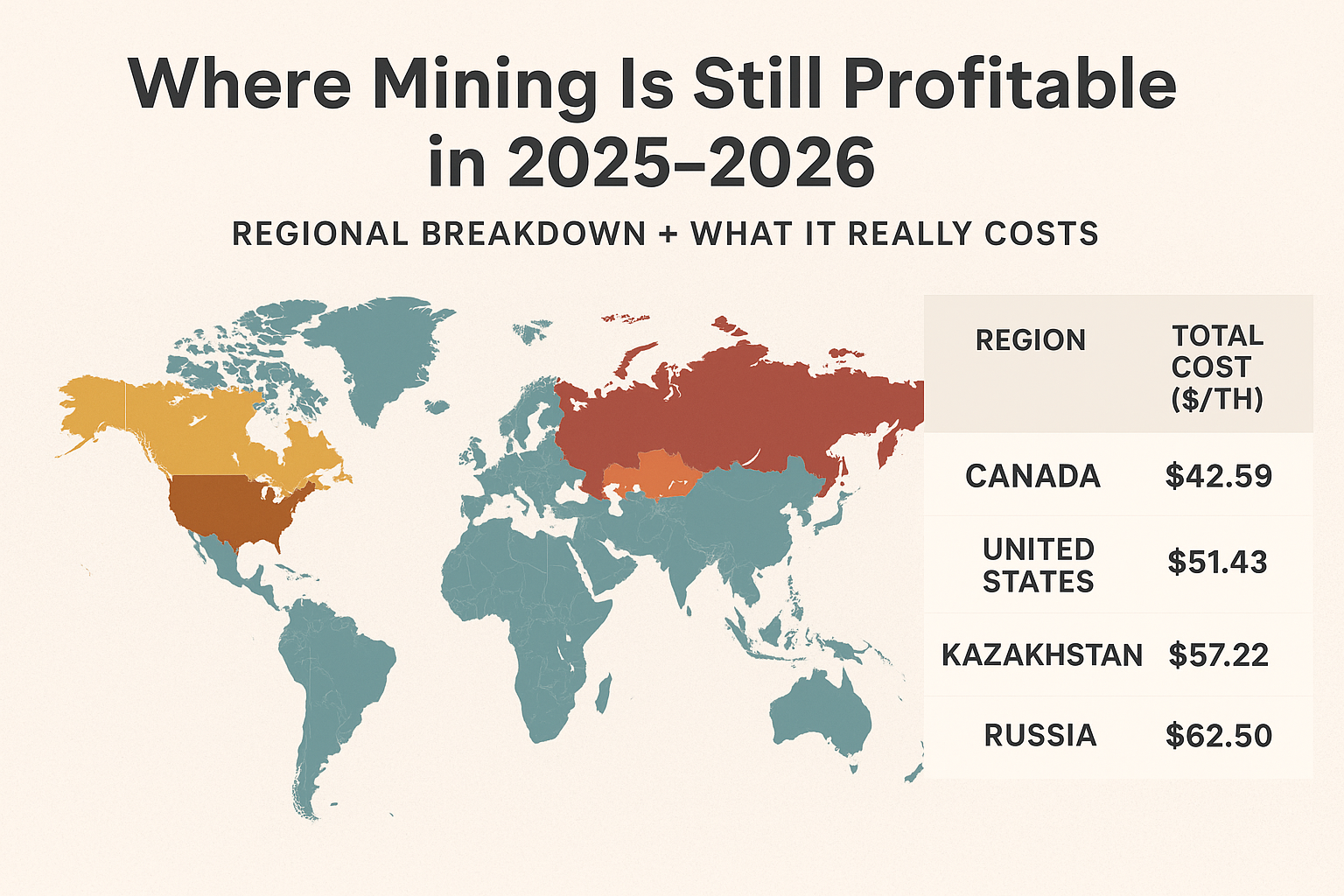
Bitcoin mining in 2025 isn’t dead—it’s just moved. While headlines scream about mining bans and energy costs, smart miners are quietly building profitable operations in unexpected places. From Kazakhstan’s frozen steppes to Paraguay’s hydroelectric valleys, the geography of mining has shifted dramatically.
The real question isn’t whether mining is profitable. It’s where and how you mine that determines success. This comprehensive guide breaks down actual costs, hidden expenses, and regional opportunities that most analyses miss.
The True Cost Equation: Beyond Electricity Rates
Electricity represents only 60-70% of total mining costs. Most profitability calculators ignore the remaining 30-40% that can make or break your operation. Understanding these hidden costs separates profitable miners from those bleeding money.
Infrastructure costs hit harder than expected. A proper cooling system adds $0.02-0.04 per kWh equivalent to your operating expenses. In hot climates like Texas or Dubai, cooling can double your effective electricity rate. Meanwhile, miners in naturally cool regions like Iceland or Northern Canada save thousands monthly on ventilation alone.
Maintenance eats profits silently. ASIC miners require cleaning every 2-4 weeks in dusty environments. Each S19 XP needs 30 minutes of maintenance weekly, costing $50-100 in labor. Scale that to 1,000 units, and you’re looking at $200,000 annually just for basic upkeep.
Real-world example: A 10MW facility in Georgia (US) budgeted $0.045/kWh for electricity but operates at $0.078/kWh all-in cost. The breakdown reveals the truth: – Base electricity: $0.045/kWh – Cooling/HVAC: $0.018/kWh – Maintenance staff: $0.008/kWh – Security/insurance: $0.007/kWh
Regional Powerhouses: Where Smart Money Mines
Kazakhstan: The Frozen Gold Mine
Kazakhstan controls 13% of global Bitcoin hashrate despite recent regulatory turbulence. The country offers industrial electricity at $0.03-0.04/kWh with minimal cooling requirements. Winter temperatures averaging -20°C provide free cooling for 6 months annually.
Recent regulatory changes actually improved conditions for legitimate operators. The 2025 mining law requires licenses but guarantees 5-year rate stability for approved facilities. This certainty attracts institutional miners fleeing regulatory uncertainty elsewhere.
Profitability snapshot for 50MW facility: – Electricity cost: $0.035/kWh – All-in operational cost: $0.052/kWh – Break-even Bitcoin price: $38,000 – Current ROI: 14 months
Paraguay: Hydroelectric Haven
Paraguay emerges as South America’s mining capital. Excess hydroelectric capacity from Itaipu Dam offers rates at $0.025-0.03/kWh for industrial users. The government actively courts miners to monetize surplus energy that currently goes to waste.
Local mining farms report exceptional results. Bitfarms’ 10MW facility achieves $0.048/kWh all-in costs including tropical cooling requirements. The stable political environment and mining-friendly regulations create ideal conditions for long-term operations.
Key advantages: – 100% renewable energy satisfies ESG requirements – Government provides 10-year tax holidays for facilities over $5 million – Direct utility contracts bypass volatile spot markets – Proximity to Brazilian tech talent pools
Ethiopia: Africa’s Dark Horse
Ethiopia’s Grand Renaissance Dam creates 6,450MW of excess capacity seeking industrial users. The government offers mining-specific rates at $0.022/kWh—among the world’s lowest. Political stability has improved dramatically since 2023, attracting Chinese and Middle Eastern mining investments.
Infrastructure challenges remain real but manageable. Import duties on mining equipment dropped from 35% to 5% in 2024, making setup costs competitive with established regions. Local partnerships provide crucial navigation through bureaucracy.
Scale Matters: Home vs Farm vs Industrial
Home Mining Reality Check
Home mining profitability depends entirely on your electricity rate. With residential rates averaging $0.12-0.16/kWh in the US and £0.34/kWh in the UK, most home setups lose money. The exceptions prove the rule.
Profitable home mining scenarios: – Solar-powered setups with battery storage (effective rate: $0.04-0.06/kWh after installation ROI) – Time-of-use arbitrage in specific markets (mining during $0.02/kWh overnight rates) – Heat recycling applications (greenhouse heating, pool warming reduces effective cost by 30%)
Case study: UK home miner with 3x S19j Pro units: – Electricity cost: £0.34/kWh (peak) / £0.07/kWh (night rate) – Mining schedule: 11pm-7am only – Heat recovery: Warms greenhouse, saving £200/month – Net profit: £180/month after all costs
Small Farm Sweet Spot (1-5MW)
Small farms hit the profitability sweet spot in many regions. Large enough for commercial electricity rates but small enough to avoid major regulatory scrutiny. This scale offers flexibility larger operations lack.
Optimal small farm characteristics: – 100-500 ASIC units – $500,000-2,500,000 initial investment – 2-4 full-time employees – Commercial rate access ($0.06-0.08/kWh typical) – 12-18 month ROI in favorable locations
Real example: 2.5MW facility in North Dakota: – 300x Antminer S19 XP – Electricity: $0.055/kWh commercial rate – Natural gas flare mitigation provides additional revenue – All-in cost: $0.073/kWh – Monthly profit: $45,000 at $65,000 Bitcoin
Industrial Scale Economics (10MW+)
Industrial mining operates on different economics entirely. Direct utility negotiations, custom infrastructure, and economies of scale create opportunities unavailable to smaller players. However, regulatory compliance costs escalate dramatically.
Industrial advantages: – Wholesale electricity rates ($0.025-0.04/kWh) – Custom cooling solutions reduce costs 40% – Bulk hardware purchasing saves 15-20% – Professional management optimizes uptime to 98%+
Hidden industrial costs: – Regulatory compliance: $50,000-200,000 annually – Environmental impact studies: $100,000-500,000 – Grid connection fees: $1-5 million – 24/7 security staff: $300,000+ annually
The Cloud Mining Trap: Why 99% Are Scams
Cloud mining scams exploded 400% in 2024 according to UK Financial Conduct Authority data. These operations prey on newcomers seeking easy mining profits without hardware hassles. Understanding their tactics protects your capital.
Red flags identifying cloud mining scams: – Guaranteed daily returns (legitimate mining has variable profits) – Referral bonuses exceeding 10% (Ponzi structure indicator) – No proof of actual mining hardware – Registered in offshore jurisdictions with no mining presence – Withdrawal restrictions or fees exceeding 5%
Recent UK fraud cases: – BitConnect Mining: £68 million stolen, 4,000 UK victims – CloudHash Pro: Fake London address, £12 million losses – MinerGate Plus: Used stolen identities, currently under investigation
Legitimate cloud mining exists but barely profits. Genesis Mining and Bitdeer provide real services but charge premiums that eliminate most profit potential. After fees, maintenance, and electricity markups, cloud mining typically returns 60-70% of direct mining profits.
Profitability Calculators That Actually Work
Most mining calculators lie through omission. They show gross revenue while ignoring operational realities. Here’s what actually matters for accurate projections.
Essential calculator inputs beyond basics: – Cooling costs (add 20-40% to base electricity) – Maintenance downtime (assume 2-3% monthly) – Difficulty adjustment projections – Hardware degradation (5-10% annually) – Tax implications for your jurisdiction
Recommended calculators with real-world accuracy: – WhatToMine Pro (includes cooling/maintenance factors) – ASIC Miner Value (real-time profitability with location data) – Braiins Profitability Calculator (open-source, customizable)
Build your own spreadsheet model for maximum accuracy. Include columns for: – Daily revenue at current difficulty – Electricity costs (peak/off-peak if applicable) – Cooling costs (seasonal variations) – Labor costs (cleaning, repairs, monitoring) – Facility costs (rent, insurance, security) – Tax provisions (income tax, VAT, import duties) – Hardware depreciation
Regulatory Landscape: Navigate or Get Crushed
Regulations make or break mining profitability. The difference between compliant operations and regulatory violations can mean prison time. Each jurisdiction presents unique challenges and opportunities.
United States: State-by-State Chaos
US mining regulations vary wildly by state. Texas welcomes miners with open arms while New York bans proof-of-work entirely. Federal oversight increases but remains manageable for compliant operations.
State-specific considerations: – Texas: No state income tax, deregulated energy market, mining-friendly policies – Washington: Cheap hydro power but increasing environmental scrutiny – Kentucky: Tax incentives for miners creating 50+ jobs – New York: Complete ban on fossil fuel-powered mining
Federal requirements (2025): – FinCEN registration for operations over $50,000 monthly revenue – IRS Form 8949 for all mining rewards – EPA emissions reporting for facilities over 5MW – CFIUS review for foreign-owned mining operations
European Union: Sustainability Focus
EU regulations emphasize environmental compliance. The Markets in Crypto Assets (MiCA) framework adds reporting requirements but provides regulatory clarity. Carbon neutrality requirements phase in by 2027.
Key EU requirements: – Renewable energy certificates for large-scale operations – Environmental impact assessments for facilities over 2MW – KYC/AML compliance for mining pools – VAT treatment varies by member state (0-27%)
United Kingdom: Post-Brexit Opportunity
UK positions itself as crypto-friendly post-Brexit. New frameworks provide clarity while avoiding EU’s stricter environmental mandates. However, electricity costs remain prohibitively high for most operations.
UK-specific factors: – No specific mining bans or restrictions – Standard corporation tax (25%) applies to mining profits – R&D tax credits available for innovative cooling solutions – Financial Conduct Authority requires registration for large operations
2026 Forecast: Prepare for Seismic Shifts
The 2026 landscape will look radically different. Current trends point to consolidation, geographical redistribution, and technological disruption. Smart miners position themselves now for tomorrow’s reality.
Key trends shaping 2026: – Bitcoin halving effects fully materialize (reward: 3.125 BTC) – Efficiency requirements jump to 15 J/TH for profitability – Stranded energy mining expands 300% – AI-optimized operations become standard – Modular nuclear reactors enter mining market
Regional predictions: – Africa emerges as major mining hub (25% global hashrate) – Central Asia consolidates around 3-4 mega-facilities – North America splits between banned and embracing states – Europe focuses on small-scale renewable operations
Technology disruptions: – Immersion cooling becomes cost-effective at all scales – Quantum-resistant algorithms require hardware upgrades – Energy storage integration provides 24/7 renewable mining – Satellite internet enables truly remote operations
Action Steps: Your Profitable Mining Roadmap
Success requires action, not analysis paralysis. Whether starting fresh or optimizing existing operations, these concrete steps guide your path to profitability.
- For new miners: 1. Calculate your true all-in electricity cost including delivery, taxes, and fees 2. Model profitability at Bitcoin prices 30% below current levels 3. Visit operational facilities in your target region before committing capital 4. Start small with 5-10 units before scaling to farm level 5. Build relationships with local utilities and regulators early
- For existing operations: 1. Audit your true operational costs including hidden expenses 2. Benchmark against regional competitors for optimization opportunities 3. Explore heat recycling applications to offset 20-30% of costs 4. Negotiate new electricity contracts leveraging grid stabilization benefits 5. Prepare for next-generation hardware with infrastructure upgrades
- Mining profitability in 2025-2026 rewards the prepared and punishes the naive. Success comes from understanding total costs, choosing optimal locations, and adapting to regulatory realities. The gold rush days ended, but professional mining operations generate consistent returns for those who approach it as a serious business.
Conclusion
Generally, it’s worth mining in a country with the sustainable energy and natural cooling. However most miners may not have to opportunity to a recommended regions. Thus if you have to opportunity to explore more regions, Kazakhstan is a one best to we prefer. Total cost of hardware, energy, labour etc is a good as energy and cooling alone in UAE. Learn how to choose the best mining hardware.



